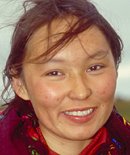TAT-C
Tat-C (haplogroup 16) is a Y-chromosome lineage that originated in Central Asia and spread to Northeastern Europe with male migrations occurring over the last 4000 years. 7C (haplogroup 12) is its ancestral haplotype, which has been dated to about 6000 Y.B.P.
(Lell et al. 2002)"The Tat-C haplogroup was observed at significant frequencies in each of the southern Middle Siberian populations studied. Surprisingly, it reached its highest frequency in the Siberian Eskimos and Chukchi from the Chukotkan peninsula. The Tat-C haplogroup was absent in the Lower Amur and Sea of Okhotsk region populations that have maintained greater geographic and/or linguistic isolation (e.g., the Udegeys, Nivkhs, and Upriver Negidals) and was only detected in the populations likely to have had recent contact or shared origins with the populations of southern Middle Siberia (e.g., the Okhotsk Evenks, Ulchi/Nanai, and Downriver Negidals). Because the Tat-C polymorphism originated on a Y chromosome containing the DYS7C deletion (haplogroup 7C), which was present only in the Middle Siberian Tuvans, Buryats, Tofalars, and Yenisey Evenks, the Tat-C haplogroup probably entered the Lower Amur and eastern Siberia from southern Middle Siberia. This conclusion is consistent with the previous hypothesis that the Tat-C and 7C haplogroups arose in central Asia and migrated west to northern Europe and east to Chukotka (Zerjal et al. 1997).
"The network of Tat-C and DYS7C haplotypes revealed that the ancestral Tat-C haplotype (7C[11-11-10-10]) was found only in southern Middle Siberia, indicating that this Y-chromosome lineage arose in that region. Moreover, the limited microsatellite diversity and resulting compact nature of the network indicates that the Tat-C lineage arose relatively recently (Zerjal et al. 1997). The absence of the Tat-C haplogroup in the Americas, with the exception of a single Navajo (Karafet et al. 1999), along with its high frequency in both northern Europe and northeastern Siberia, indicates that the Tat-C lineage was disseminated from central Asia by both westward and eastward male migrations, the eastward migration reaching Chukotka after the Bering Land Bridge was submerged. Both the M45 and Tat-C haplogroups have been found in Europe, indicating both ancient and recent central Asian influences. However, neither of these major Middle Siberian Y-chromosome lineages appears to have been greatly influenced by the paternal gene pool of Han Chinese or other East Asian populations (Su et al. 1999)."
* * *
Tat-C Frequencies
| Yakuts..........87% Eskimos.........61% Chukchi.........58% Finns...........55% Buryats.........52% Tofalars........47% Lithuanians.....47% Lapps...........42% Estonians.......37% Maris...........33% Latvians........32% Nenets..........30% Tuvans..........18% |
Chuvash.........18% Russians........14% Ukrainians......11% North Swedes.....8% Gotlanders.......6% Norwegians.......6% Poles............4% Germans..........3% Armenians........3% Slovakians.......3% Danes............2% Belarusians......2% Turks............1% |
7C Frequencies
| Nenets..........50% Tofalars........47% Tuvans..........28% Buryats.........15% Maris...........17% Czechs...........6% Estonians........4% |
Russians.........4% Finns............2% Yugoslavians.....2% Cypriots.........2% Poles............1% Slovakians.......1% Turks............1% |
Individuals with phenotypes that are likely to be the product of Tat-C, 7C or other Uralic ancestry:
 Yakut |
 Nenet |
 Chuvash |
 Lappish |
 Finnish |
 Swedish |
 Icelandic |
 German |
 Latvian |
 Lithuanian |
 Russian |
 Ukrainian |
Related TopicsEuropean Genetic Variation: Tat-C and 7C comprise much of the 2nd component of variation.


